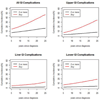Survivors of childhood cancer have increased risk of gastrointestinal complications later in life
- PMID: 21315721
- PMCID: PMC3081911
- DOI: 10.1053/j.gastro.2011.01.049
Survivors of childhood cancer have increased risk of gastrointestinal complications later in life
Abstract
Background & aims: Children who receive cancer therapy experience numerous acute gastrointestinal (GI) toxicities. However, the long-term GI consequences have not been extensively studied. We evaluated the incidence of long-term GI outcomes and identified treatment-related risk factors.
Methods: Upper GI, hepatic, and lower GI adverse outcomes were assessed in cases from participants in the Childhood Cancer Survivor Study, a study of 14,358 survivors of childhood cancer who were diagnosed between 1970 and 1986; data were compared with those from randomly selected siblings. The median age at cancer diagnosis was 6.8 years (range, 0-21.0 years), and the median age at outcome assessment was 23.2 years (5.6-48.9 years) for survivors and 26.6 years (1.8-56.2 years) for siblings. Rates of self-reported late GI complications (occurred 5 or more years after cancer diagnosis) were determined and associated with patient characteristics and cancer treatments, adjusting for age, sex, and race.
Results: Compared with siblings, survivors had increased risk of late-onset complications of the upper GI tract (rate ratio [RR], 1.8; 95% confidence interval [CI], 1.6-2.0), liver (RR, 2.1; 95% CI, 1.8-2.5), and lower GI tract (RR, 1.9; 95% CI, 1.7-2.2). The RRs for requiring colostomy/ileostomy, liver biopsy, or developing cirrhosis were 5.6 (95% CI, 2.4-13.1), 24.1 (95% CI, 7.5-77.8), and 8.9 (95% CI, 2.0-40.0), respectively. Older age at diagnosis, intensified therapy, abdominal radiation, and abdominal surgery increased the risk of certain GI complications.
Conclusions: Individuals who received therapy for cancer during childhood have an increased risk of developing GI complications later in life.
Copyright © 2011 AGA Institute. Published by Elsevier Inc. All rights reserved.
Conflict of interest statement
There are no conflicts of interest.
Figures
Comment in
-
Childhood cancer survival: a risk factor for GI disease.Gastroenterology. 2011 May;140(5):1383-6. doi: 10.1053/j.gastro.2011.03.028. Epub 2011 Mar 26. Gastroenterology. 2011. PMID: 21443888 No abstract available.
References
-
- Jemal A, Siegel R, Ward E, Hao Y, Xu J, Murray T, Thun MJ. Cancer statistics, 2008. CA Cancer J Clin. 2008;58:71–96. - PubMed
-
- Di Fiore F, Van Cutsem E. Acute and long-term gastrointestinal consequences of chemotherapy. Best Pract Res Clin Gastroenterol. 2009;23:113–124. - PubMed
-
- Shafi MA, Bresalier RS. The gastrointestinal complications of oncologic therapy. Gastroenterol Clin North Am. 39:629–647. - PubMed
-
- Robison LL, Green DM, Hudson M, Meadows AT, Mertens AC, Packer RJ, Sklar CA, Strong LC, Yasui Y, Zeltzer LK. Long-term outcomes of adult survivors of childhood cancer. Cancer. 2005;104:2557–2564. - PubMed
-
- Robison LL, Mertens AC, Boice JD, Breslow NE, Donaldson SS, Green DM, Li FP, Meadows AT, Mulvihill JJ, Neglia JP, Nesbit ME, Packer RJ, Potter JD, Sklar CA, Smith MA, Stovall M, Strong LC, Yasui Y, Zeltzer LK. Study design and cohort characteristics of the Childhood Cancer Survivor Study: a multi-institutional collaborative project. Med Pediatr Oncol. 2002;38:229–239. - PubMed
Publication types
MeSH terms
Grants and funding
LinkOut - more resources
Full Text Sources


